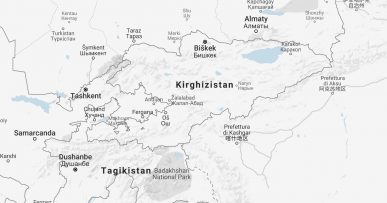In this article, you can find hints about the history of Samarkand as well as information about the main tourist attractions.
The city of Samarkand is broadly speaking synonym of Silk Road and it has actually been at the crossroads of world cultures and religions for over two and a half millennia. Located in north-eastern Uzbekistan, the city enjoys the benefits of abundant natural resources and settlement in the region can be traced back to 1,500 BC.
A Brief History of Samarkand
Samarkand has long been a central point for trade across the region, and was a substantial city renowned for its craft production, with a citadel and strong fortifications, several centuries before it was conquered by Alexander in 329 BC. From the late antique and early medieval period, the city and the surrounding area were inhabited by the Sogdians, a people of Iranian origins renowned for their skill at trading. As early as Han times (206 BC-220 AD), when the Chinese first committed to writing their impressions of Inner Asia, Sogdian merchants are recorded in the Chinese descriptions of the region. Sogdian colonies were established all along the trade routes and Sogdian letters have been discovered from 313-314 AD, providing evidence about a network of merchants from Samarkand, reaching various places as far as China, in order to trade precious metals, spices and cloth (this and the following quotes come from unesco.org).

The Arab armies of the Umayyad Caliphate under Qutayba ibn Muslim captured Samarkand in 710. During this period, the city was home to a number of religions including Zoroastrianism, Buddhism, Hinduism, Manichaeism, Judaism, and Nestorian Christianity. In Central Asia, Qutayba generally forced the local rulers to pay tribute but largely left them to their own devices; Samarkand was the major exception to this policy and an Arab garrison and administration was established in the city, its Zoroastrian fire temples were razed and a mosque was built. Much of the population of the city converted to Islam and, as a long-term result, Samarkand developed into a center of Islamic and Arabic learning. Ummayad Caliphate was soon replaced by the Abbasid, but Abbasid control of Samarkand soon dissipated and was replaced with that of the Samanids (862–999), who were of Iranian origin. During that time, the city became an even more important link amongst numerous trade routes. The Samanids were overthrown by the Karakhanids around 1000 and, during the next two hundred years, Samarkand would be ruled by a succession of Turkic tribes, including the Seljuks.
Samarkand was invaded and destroyed by Genghis Khan and his Mongol armies when they conquered the area in 1220, and much of its historic architecture was reduced to ruins, with only fragments of the walls remaining. The real rebuilding of Samarkand and its resurrection as a great city had to await the emergence of Tamerlane, the founder of the Timurid dynasty, who decided to make it his capital city in the 1370s. One of his first moves was to build a central high-street and line it with shops, thus encouraging trade and the development of a merchant economy. He also wanted to commemorate his wife through Bibi Khanym Mosque, built in Samarkand between 1399 and 1404. A contemporary chronicler relates that Tamerlane brought in architects from Iran and India for the project and used ninety-five elephants to haul construction material. The site has been mainly rebuilt and a line can be clearly seen on the upper part of the facade of the main building. However, it’s interior hasn’t been renewed yet and thus gives an idea of how it was in the past, on the one hand, and the massive work that has been done to bring this and other historical buildings back to life, on the other hand.


The city’s development continued under Tamerlane’s grandson Ulugh Beg, who ruled the city for much of the first half of the fifteenth century until his assassination in 1449, and developed Samarkand as something of a scientific centre, in particular building an important observatory in 1420. The sextant was 11 metres long and once rose to the top of the surrounding three-storey structure, although it was kept underground to protect it from earthquakes. Calibrated along its length, it was the world’s largest 90-degree quadrant at the time. Also, determination of astronomical concepts such as inclination of the ecliptic to the celestial equator had a great importance on mediaeval astronomy. Estimation precision is incredible: 23° 30′ compared to today’s 23° 27′.
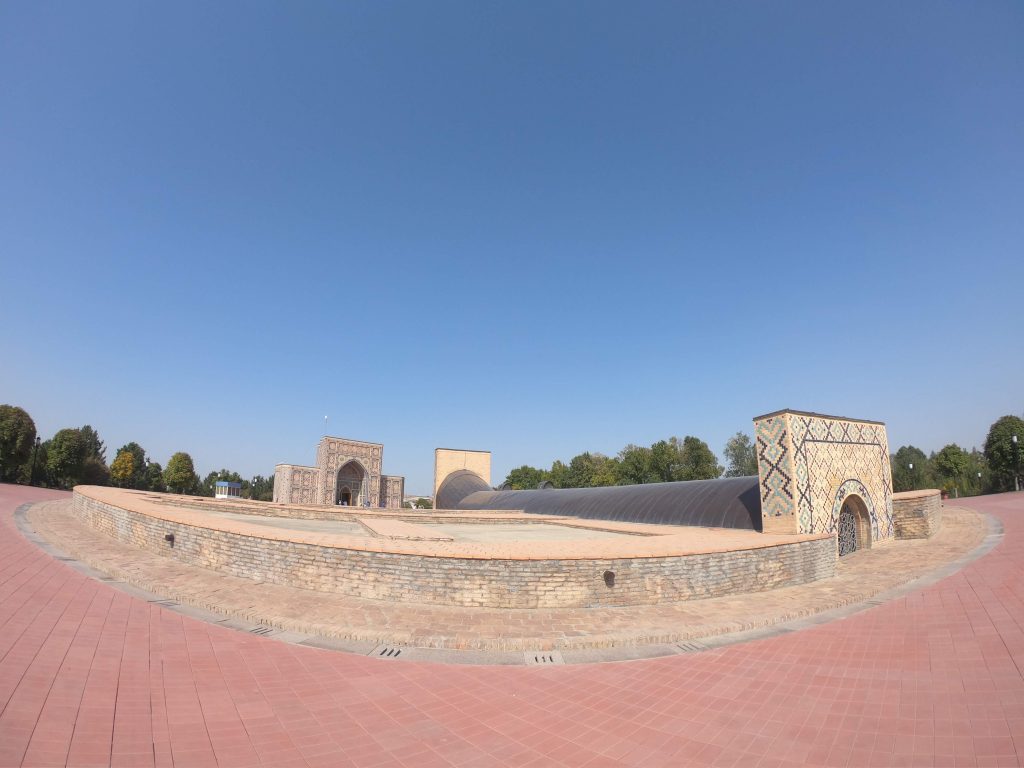

The city was conquered by the Shaybanids in 1500, an Uzbek tribe led by Muḥammad Shaybānī Khan, who incorporated Samarkand into their recently acquired khanate of Bukhara. Several important buildings date from this period, notably the Sher-Dor Madrasah, built between 1619 and 1636, and the Tilya-Kori Madrasah, constructed just afterwards from 1646 to 1660 – both are now part of the Registan complex. Nonetheless, with Bukhara as the capital, Samarkand declined and was uninhabited by the late 18th century, only reviving with the introduction of the railway in 1888, which allowed the city to regain its ancient role as a trading centre at the crossroads of routes to east and west.

It became the capital of the Uzbek Soviet Socialist Republic in 1925 before being replaced by Tashkent in 1930. In the early 1960s , the Uzek SSR was involved in a massive programme to substantially increase cotton production, which had future catastrophic impact. Indeed, this drive led to overzealous irrigation withdrawals of irrigation water from Amu Darya river and the subsequent Aral Sea ecological disaster (see our article ‘A guide to Nukus and Moynaq | 48hrs in Karakalpakstan‘ for more details about it).
On a strictly political point of view, the Uzbek SSR was renamed the Republic of Uzbekistan and declared its independence on 1 September 1991 formally remaining a part of the Soviet Union until 26 December 1991. These steps have been led by Islam Karimov. Uzbek leader of the Communist Party of Uzbekistan since 1989 and subsequently head of that party’s reincarnation, the People’s Democratic Party (PDP), he became the President of the Uzbek SSR from 24 March 1990 until he declared the independence of Uzbekistan. He was President of the Republic of Uzbekistan from 1 September 1991 to 2 September 2016, when he died at the age of 78 years old. He has been renamed “The Father of Modern Uzbekistan” and celebrated across the country. However, he was always re-elected winning between 80-90% of the votes and thus widely criticized by western media and observers.
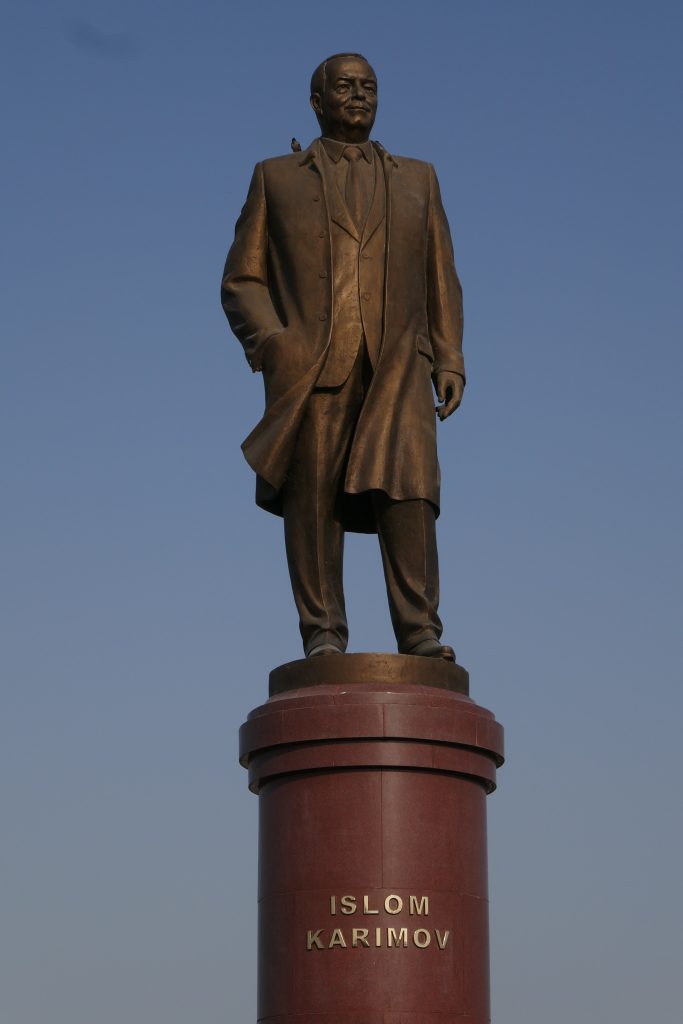
What to do in Samarkand
Samarkand is big and plenty of interesting sites and areas to visit. We spent 4 days there and we could visit it by calm. We stayed at Platan Hostel and we loved it. It’s the just-open cheap version of Platan Hotel so you have the comfort of a hotel room, you need to share the toilet though, and a common kitchen as in a hostel; indeed, we cooked almost every day.
We arrived at Samarkand train station at 5 am.. not the best time ever but that was the only option (see our article ‘2 weeks in Uzbekistan’ for more details about it) Anyway, we had made sure we could go to the hostel at that time and so we did. We found the hotel and the restaurant, the door between them was the hostel, so we entered and laid on the comfy sofas at the entrance. We then went to the hotel reception and fortunately at 8 am a room was given to us. We were super tired so we decided to rest and leave the visit to the afternoon. It was a good idea! We went for lunch in a local restaurant and had nice shashlik (meat sticks) and, after discussing about the wrong bill, we continued our walk till the Registan (the main old town).

We saw it from far away and it was quite impressive; we got closer and we realized there was a high wall surrounding it. We crossed a gate but we couldn’t go further so we had to circumnavigate all the site to get to the entrance. Unfortunately, building walls is a thing in Samarkand. The government thought it was better to isolate the tourist sites from people’s homes so as to cover up the “ugly” part of the city – which is not, of course.

We finally got to the official entrance and visited the three madeasas that make up the so called Registan. They are all very fascinating and inside it’s also possible to see some old pictures of the site and once again realize the massive renovations that were made.


On our second day we decided to go straight to the previously mentioned Bibi Khanym mosque and then to visit the surrounding area. We took a city bus and we experienced the effectiveness of having a ticket guy shouting all the stops to get passengers! So funny 😄 We paid 3,000 som each and got off at Shodiyona bus station in front of the tourist bazar. Few steps up and we saw the stunning Bibi Khanym! The facade and the three buildings are impressive and old details have been left where renovations have been completed… Look for them!



After the visit, we were very hungry so we crossed the bazar looking for something to eat… nothing. We went back to the bus station and after a quick look around and we saw our place! A very local restaurant on the opposite side of the road where we had a delicious, but small, nohot shurba (soup with chickpeas and meat). Then, we went to the nearby Hazrati mosque but we didn’t enter; we just saw the mausoleum of Islam Karimov and the view over Bibi Khanym.

We continued walking across the cemetery in order to reach the beautiful mausoleum complex of Shah-i Zinda. The street of mausoleums facing each other makes it one of the best sites in Samarkand. It includes two dozen mausoleums and a couple of small mosques and most of them date from the mid-14th to mid-16th centuries. Numerous inscriptions, some dated, and the extensive preservation of the ceramic tiles on the buildings provide a unique overview of the architectural decoration for a very significant century in the history of Islamic art in Central Asia.
After checking out carefully all the buildings and the ceramic tiles, we were happy with our visit and decided to continue exploring the neighborhood on the opposite side of the road. That’s a residential area and it shows you the real Samarkand, the one isolated by the walls; indeed, there is one between it and Bibi Khanym complex and you have to cross a gate to go from one side to another. Waving around was nice and we could see Gumbaz Synagogue (knock on the door and the guardian will open), Mubarak mosque, and Qarabay Aqsaqal mosque. This latter is characterized by a finely decorated ceiling and a traditional bakery nextdoor; we could see how the traditional roundy bread is baked and taste it warm.


On our day three, we went straight to the post office to send 22 postcards to families and friends! Then, we grabbed a street kabab and walked till Gur-e Amir (Amir Timur Mausoleum) where indeed we could see Timur (Tamerlane) tomb inside a golden shining room. The AkSaray Mausoleum behind it is nothing special; it can be skipped.
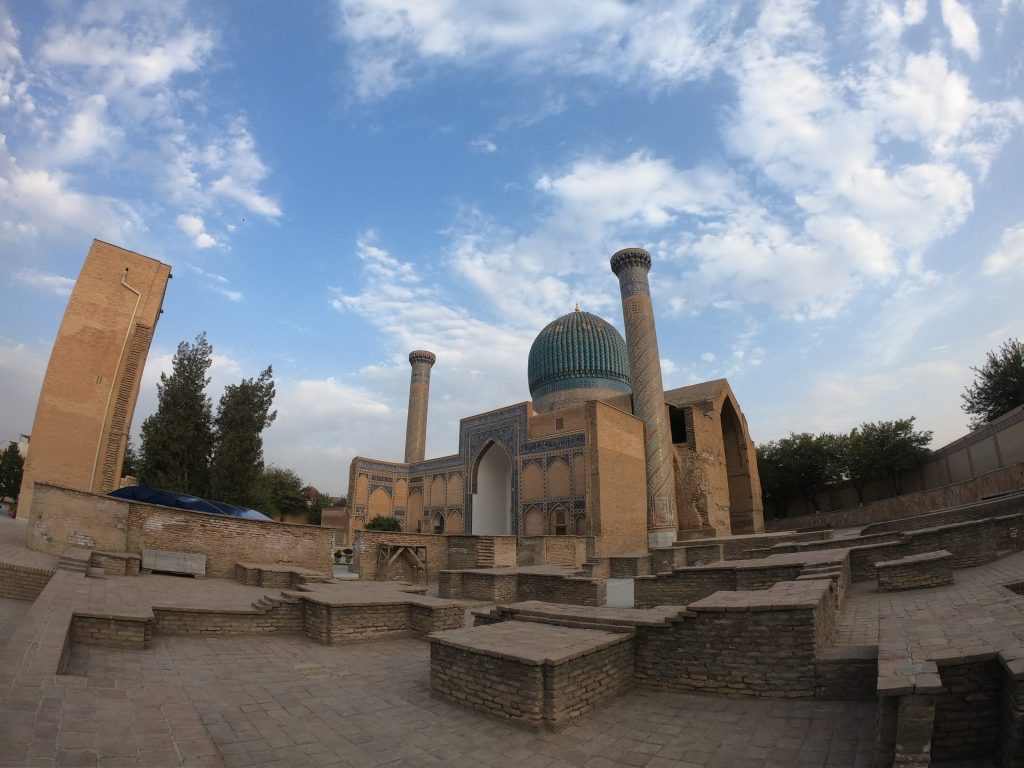

After that, we waved around the so called Russian neighborhood meeting some lovely school girls who were super happy to know that Giulia is a teacher (such an awe doesn’t happen anymore in Italy, unfortunately). The plan was to get to Imam Maturidi Mausoleum and to see it lit up at night… well, we found it but it was close and dark. A bit disappointed and tired, we continued our walk till the Registan and there we were amazed by the lightening. It may be better at night than during the day time.

The last day, we took a taxi (10,000 som) to get to Ulugh Beg Observatory. The museum is very well done and easy to understand also if you know nothing about astronomy. The remaining part of the sextant is impressive, so it’s really worth a visit. We then walked downhill looking for a place to eat. We found a tiny local restaurant where we had samsa and shurba (of course); after a thousand smiles and rakhmat (thank you) we walked to Afrasyab, the old city. Well, there is nothing but a museum and we decided we were too tired for it. Instead, we kind of hitchhiked to go to Imam Maturidi Mausoleum, this time for real! A man with a bizarre Soviet car stopped and we gave him 5,000 som to take us to the Mausoleum. This is actually very unique due to its external decorations; the interior is just white, though. You can see it from the street but if you want to properly enjoy it, we recommend to pay the ticket.
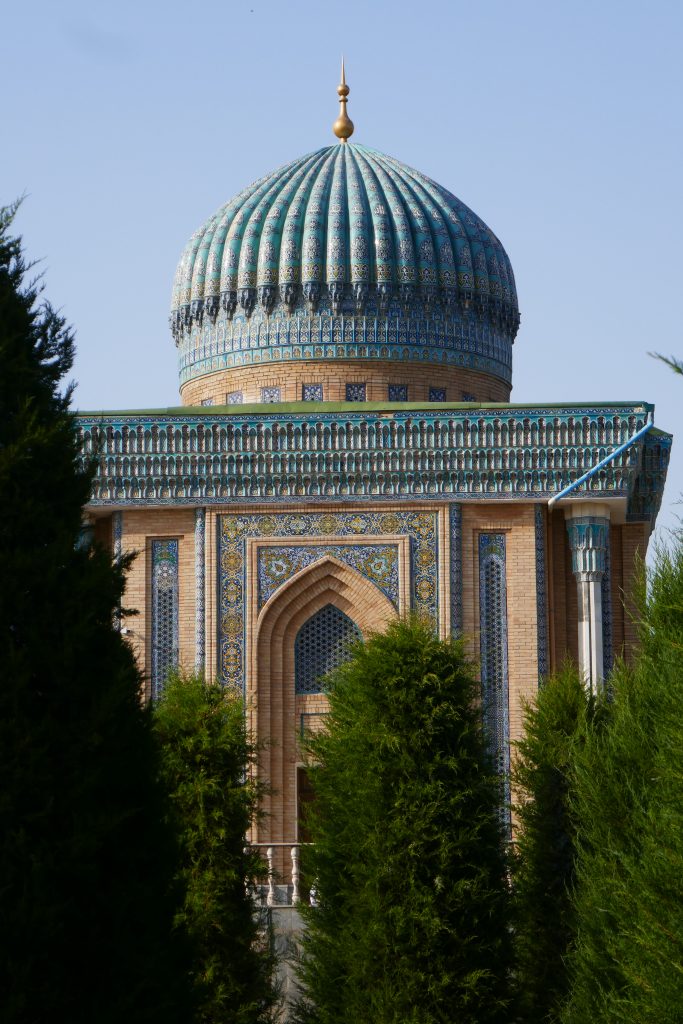
That was our last sightseeing in Samarkand. The city is fascinating due to its history and beautiful buildings and we surely recommend a visit, but we felt it’s missing the authenticity we found in Iran, where no walls are built to isolate the local people from the tourist sites.
From Samarkand we took a shared taxi to go to Dushanbe; another border was waiting for us! Tajikistan was not part of our original plan but Maris (our new friend from the Caspian sea ferry) was so persuasive that we decided to cut five days off our journey in Uzbekistan and do the Pamir Highway, instead. Was it a good idea? Read our next article to know the answer!





